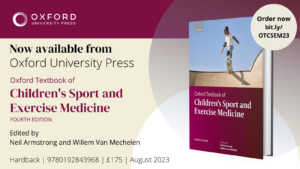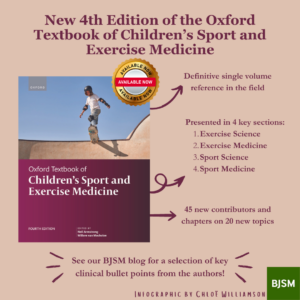Authors: Neil Armstrong and Willem van Mechelen
We are pleased to highlight the newly published 4th edition of the Oxford Textbook of Children’s Sport and Exercise Medicine, and to share some key clinical messages.

In 1999, realising that there was likely to be a huge surge in interest in youth sport and exercise medicine and that there was no significant book in the field, Willem and I proposed to Oxford University Press (OUP) a comprehensive text on Paediatric Exercise Science and Medicine co-authored by internationally recognised scientists and clinicians. The book was published in 2000 with 41 chapters, 472 pages, and 59 contributors, from 37 universities and university hospitals, in 14 countries. The book was very well-received and generally recognised as the definitive text in the field. Following 2nd (2007) and 3rd (2016) editions, this newly published 4th edition was published in August 2023 with 54 chapters, 784 pages, and 104 contributors, from 67 universities and university hospitals, in 25 countries. The 4th edition includes 45 new contributors and chapters on 20 new topics.
“The 4th edition of the Oxford Textbook of Children’s Sport and Exercise Medicine is the definitive single-volume reference in the field. It is presented in four sections Exercise Science; Exercise Medicine; Sport Science; and Sport Medicine; which between them systematically address the science and medicine underpinning physical activity, exercise, fitness, health, and sport in childhood and adolescence. All chapters are extensively referenced to promote further study and cross-referenced within and across sections where appropriate to enable interested readers to easily access complementary information. Each chapter concludes with a bulleted summary of its content.”

A selection of clinical bullet points
- Exercise and physical activity perturb homeostasis (temperature, pH, tissue injury etc) and like pathogens can activate and ultimately condition the immune and inflammatory responses early in life with impacts across the lifespan. (Ch 14).
- Prospective studies consistently demonstrate greater bone mass and strength accrual in adolescents engaged in moderate-to-vigorous and vigorous physical activity. Prepuberty and early puberty appear particularly sensitive periods when bone adapts to weight-bearing physical activity. Bone structure and strength adapt more positively in female athletes who start training prior to menarche. (Ch 22).
- Regular exercise improves several diabetes-related clinical outcomes and protects against the development of diabetes-related comorbidities. However, each exercise session presents some threat to glucose control in the child or adolescent living with type 1 diabetes and various clinical management strategies need to be in place to help support glucose control during and after exercise. (Ch 23).
- Provided that the child with asthma and her or his parents are trained in the management of exercise-induced asthma, that the disease is treated adequately, and that the methods to prevent bronchoconstriction with exercise are consequently employed, nearly every child with asthma can engage in all types of physical activities. (Ch 24).
- Recent studies have supported small- to medium-sized beneficial effects of exercise interventions on mental health outcomes in children and adolescents. (Ch 27).
- Understanding the injury context specifically for youth athletes is key to developing appropriate interventions. Injury prevention programmes should fit with the context in which they are implemented, otherwise they will not be adopted on the field. (Ch 42).
- One injury that is of special concern in contact and collision sports is a concussion which can occur without loss of consciousness. Prevention of concussions should be a prime focus area and a youth athlete with post-concussive symptoms should not return to play. (Ch 45 and Ch 47).
- The benefits of sport and physical activity for youth with disabilities are vast and include improved psychosocial, emotional, and physical domains. (Ch 50).
- Since disordered eating (DE) and eating disorders (EDs) exist among youth athletes, it is important to understand the risks and triggers of DEs and EDs. Prevention is the best treatment and strategies should integrate education and screening for early identification. (Ch 51).
- Only a very small number of dietary supplements will have a beneficial effect on performance for youth athletes who have no nutritional deficiencies. Moreover, some common supplements are known to be harmful and carry a risk of serious adverse health effects as well as the possibility of a failed doping test. (Ch 52).
- Education in prevention of doping behaviour is critical to youth development in sport. (Ch 53).
- Sport medicine physicians should have the clinical competence to recognise youth athletes who have experienced harassment and abuse in sport, to manage athlete disclosures, and to clinically support the mental and physical sequelae of survivors of abuse. (Ch 54).